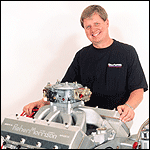By David Reher, Reher-Morrison Racing Engines
“Excessive valve clearance is the enemy of compression – and compression is your best friend in a naturally aspirated racing engine.”
One of the most common mistakes I see in engine building is excessive valve clearance. One of the rules at our shop is that we always check the valve clearance in any engine that we didn’t build before it’s torn down.
We often find that the owner or engine builder has left a lot of compression on the table.
Excessive piston-to-valve clearance is the enemy of compression – and compression is your best friend in a naturally aspirated racing engine (but only up the point where it induces detonation).
Why is compression desirable? In short, higher compression makes an engine more efficient. Raising the compression ratio increases cylinder pressure, and cylinder pressure is what drives the pistons, turns the crankshaft, and ultimately makes the wheels go around. You can also think of compression ratio as the engine’s “expansion ratio” – as the combustion gases expand from a small volume to a larger volume, they produce usable power. The more these gases expand, the more power they make.
A high-compression engine typically produces best power with less spark advance than a low-compression engine. That’s beneficial because more of the power pulse occurs after the piston has passed top dead center (TDC) and the expansion of gases in the cylinder is driving the piston downward. In an engine that requires more spark advance, some of the power of the expanding gases is wasted as negative work, pushing against the piston while it is still rising in its cylinder. The gains in efficiency produced by increasing compression can be documented on a dyno as the brake specific fuel consumption (BSFC) goes down.
To a large extent, valve clearance determines the compression ratio because the piston’s valve notches account for much of the combustion volume. I learned about the relationship between valve clearance and compression ratio back when we were building 287-cubic-inch Modified engines in the ’70s, and it’s a lesson that has stayed with me for 40 years. Those engines had relatively little swept volume compared to the big-inch engines we build today, so squeezing every bit of compression was a challenge. But you have to pay attention to valve clearance even in a large displacement engine. An extra .100-inch of valve clearance in a 632ci big-block costs a full point of compression ratio, and that has a major impact on performance.
In a typical sportsman drag racing engine, I recommend .075-inch intake valve clearance and .120-inch exhaust valve clearance. An engine that is maintained rigorously with fresh valve springs and regular inspections can run less valve clearance, but an extra safety margin is advisable for a sportsman engine that will run dozens (or hundreds) of races between rebuilds.
Why does the exhaust valve need more clearance than the intake valve? First, the components are hotter on the exhaust side and they expand more due to the intense heat. But the chief reason for the difference is the relationship between the piston and the valves. On the intake side, the closest point between the valve and piston typically occurs at 10 degrees after top dead center (ATDC). The intake valve is opening against the resistance of the spring and the piston is moving away from the valve. The situation is quite different on the exhaust side: the minimum clearance point is usually around 10 degrees before top dead center (BTDC) when the valve is closing. The valvetrain may be essentially unloaded at this point, and if there is any instability as the lifter and valve loft over the nose of the cam, the piston can catch up with the valve. In short, the intake valve chases the piston, while the piston chases the exhaust valve.
Checking valve clearance in an unfamiliar engine is straightforward. We check at the points of minimum clearance by putting a dial indicator on the retainer or the edge of the valve spring. After checking that the lash is correct, we then run the valve down with the adjuster until it just contacts the piston.
It’s not uncommon to find engines with .150 to .200-inch clearance on the intake valves. I understand why this happens. With the huge variety of cylinder heads, camshafts, and valvetrain components that are available, the piston manufacturers must be cautious. The last thing a piston maker wants to hear from a customer is that the valves hit the pistons and destroyed an engine. While off-the-shelf pistons have a place in racing, if you want to optimize valve clearance and compression, you should work with an experienced professional engine builder who can order pistons specifically for your application.
One consequence of excessive valve clearance is often a dome that is too large. In order to compensate for the loss of compression in the valve notches, a manufacturer may increase the height and volume of the dome – which then disrupts the flame travel from the spark plug across the cylinder. You’re better off having correct valve clearance and a shorter dome that encourages efficient combustion.
Another unintended consequence of excessive valve notches is weakness in the top ring grooves. The deeper the valve relief, the less material there is above and behind the groove. If the top ring is high on the ring band (which it should be for optimum performance), then the piston material is may be thin in this area. When the aluminum is superheated by the heat and pressure of combustion, it can crack or cause preignition, which can quickly lead to catastrophic failure. It’s like you’ve got a 14-gauge wire where you should have an 8-gauge wire. What happens? You melt the insulation off and it burns up. That’s a simplified explanation, but essentially that’s what happens.
Compression matters in a racing engine. Don’t give it away with excessive valve clearance. You’ll see a difference on the dyno and on your time slip.

